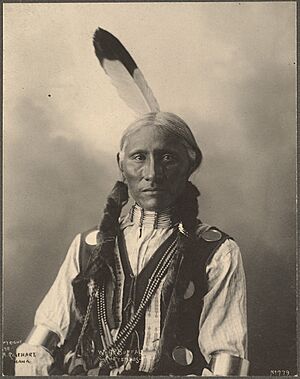White Buffalo (Cheyenne leader) facts for kids
White Buffalo (born 1862 – died June 1929) was an important leader of the Northern Cheyenne people. He was born in what is now Montana but, like many of his tribe, was later moved to Oklahoma. He spent most of his life on the Cheyenne and Arapaho Reservation there. In 1884, he graduated from the Carlisle Indian Industrial School in Carlisle, Pennsylvania. This was a special school for Native American students.
After school, White Buffalo returned to Oklahoma. He worked as an Indian scout in his twenties. As he grew older, he became a respected chief of his tribe. His picture was even taken by Frank Rinehart, a famous photographer, at the 1898 Indian Congress in Omaha, Nebraska. This event brought together 500 tribal members from 35 different tribes. In 1929, White Buffalo led a group of 108 Native Americans from Oklahoma to Washington, D.C. They went to support Charles Curtis, who had Native American heritage, as he became the Vice President of the United States. White Buffalo was married to Medicine Woman, and they had three sons. He passed away in June 1929 and is buried on the reservation.
Contents
Early Life and Moving South
White Buffalo was born in Montana, just like his parents. The Cheyenne people used to travel widely, hunting from Montana all the way to Texas. In 1867, the U.S. government made a treaty that forced many Northern Cheyenne and Arapaho people to move south. They were sent to a reservation in what is now Oklahoma.
Life on the reservation was hard. The tribe often did not receive enough food from the government agency. Because of this, many people from his tribe left the reservation. They walked all the way back to their homelands in the Dakota Territory. White Buffalo was about 15 years old when the famous Battle of Little Bighorn happened. Many Cheyenne people from Montana took part in that battle.
His Education
The first school on the Darlington agency opened in 1875. White Buffalo likely attended this school. Later, he was sent to the Carlisle Indian Industrial School in Pennsylvania. This school aimed to teach Native American children new ways of life.
Records show that White Buffalo arrived at Carlisle in February 1881. He studied there for three years, leaving in June 1884. After graduating, he returned to the Darlington agency. He first worked in the agency's sheet metal shop. As a Carlisle graduate, he sometimes faced challenges from people in his tribe who wanted to keep traditional ways.
Family Life
Newspaper articles from 1902 described White Buffalo as having a striking look. His hair had turned completely white when he was still young. A photo from his time at Carlisle shows this, where he is wearing a suit and has a short haircut.
In 1888, when he was 26, White Buffalo married Medicine Woman. She was 30 and also a Northern Cheyenne. She had also been born in Montana. In 1905, they had four children listed: Emma, Receiving Roots, Paul, and Pratt. By 1910, they had three sons who were still living: John, James, and Fred. Medicine Woman's mother, Siege Woman, also lived with them.
White Buffalo and Medicine Woman received land on the reservation in 1891. This was part of a program to give land to Native American families. His son, John White Buffalo, later served in World War I. White Buffalo lived to be 67 years old. He passed away on June 23, 1929. He was buried at the Indian Mission Church on the reservation.
Working for His Tribe
After returning from Carlisle, White Buffalo was chosen for special farming training. He later served as an Army scout. After getting his own land, he built a home for his family and started farming. This showed he was adopting some new ways of living.
White Buffalo became a chief, which meant he was a respected leader. He attended important meetings called Indian Congresses in 1898, 1901, and 1904. Because he could read and write, he helped his tribe work with the agency leaders. Many tribal members could not read or write, so his skills were very helpful.
Just a few months before he died in 1929, White Buffalo led a group of 108 Native Americans to Washington, D.C. They went to support Charles Curtis, who was becoming the Vice President of the United States. This showed White Buffalo's continued importance as a leader.
Additional Reading
- They Called Me Uncivilized, by Walter Littlemoon.
- Tell Them We Are Going Home: The Odyssey of the Northern Cheyennes, by John H. Monnett.


